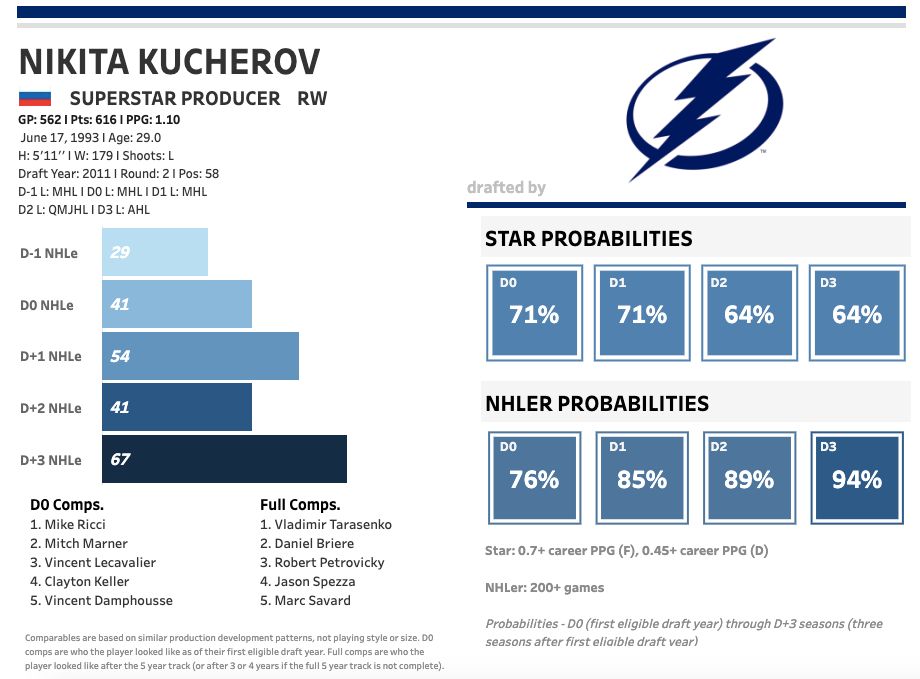On Monday, Taylor Haase broke down the odds of the Penguins' upcoming 2022 draft picks becoming regular players in the NHL.
Although it's a long shot for any player drafted outside the first round to establish a lasting NHL career, nearly every year there are players drafted in the later rounds who carve out a role for themselves in the bigs. Some even become star players.
According to Byron Bader, a data scientist turned draft and prospect analyst, under 30% of players drafted in the second round or beyond between 2005 and 2013 ended up playing 200 or more NHL games. Again, it's a long shot, but the fact remains: NHL-caliber players can be found beyond the first round ... if you know what to look for.
Now, don't expect the Penguins to be the team to find the next diamond in the rough (especially because they are without picks in the second and third rounds), but take a look at the draft position of some notable players around the league:
• Nikita Kucherov -- Round 2, pick 58 (2011)
• Johnny Gaudreau -- Round 4, pick 104 (2011)
• Colton Parayko -- Round 3, pick 86 (2012)
• Tyler Bertuzzi -- Round 2, pick 58 (2013)
• Jake Guentzel -- Round 3, pick 77 (2013)
• Brayden Point -- Round 3, pick 79 (2014)
• Roope Hintz -- Round 2, pick 49 (2015)
At worst, all of those players are positive contributors toward the top of the lineup on their respective teams, yet in some cases, they were passed over several times before being selected.
Here are two factors teams can consider to squeeze some value out of their picks after the first round.
SIZE ISN'T EVERYTHING
Let's not forget that within this exercise, we are merely splitting hairs. For the most part, the cream of the crop of each draft class are easily identifiable. Whether it's the display of high-end skills like magnificent skating or ridiculous point totals -- or a combination of both -- the truly generational players aren't slipping through the cracks.
You won't find the next Connor McDavid in the middle of the third round.
The margins between the players of each class get thinner and thinner the further down the board you go. As the skills start to stand out less and less, far more subjectivity comes into play regarding a bunch of teenagers that aren't even close to the end of their physical or mental development.
This is not to say plain eyeball scouting takes a backseat here -- it's by far the most imperative component -- but at some point, there needs to be an acceptance that players are or aren't putting up points for a reason. I'll be the first to tell you there's far more to being a good hockey player than getting on the scoresheet, however, even the players who become defensive specialists tend to stand out among their peers in point production before being drafted.
Especially as it relates to size, this can't be galaxy-brained here. An undersized player racking up points in the OHL, for example, shouldn't have less perceived value than a bigger player putting up fewer points in the same league for the sole reason that they are small. Yet we've seen small players like Gaudreau, who was a strong producer, fall deep in the draft due to his size.
No, not every small pre-draft producer will pan out and, no, you can't build a team entirely of undersized players with skill. You can build a team around those skillful undersized players and deploy them in a manner that leverages their strengths.
Don't gloss over the next Gaudreau in fear he'll be bullied by the time he reaches the NHL.
NHLe
NHLe, or NHL equivalence, is a tool that standardizes any player's point production in their given league to an 82-game NHL point total. For example, an OHL player with an NHLe of 30 would have produced roughly 30 points in the NHL based on their point total for that season.
The nuance of comparing production across various leagues can be seriously reduced by utilizing NHLe, as it puts all prospects on a relatively even playing field.
NHLe can also reduce hesitations among scouts and front office members regarding undersized players, or maybe a player with a wonky skating stride.
There are various NHLe models and surely every NHL franchise has developed their own, it just boils down to how much credibility it's given.
A decade has passed and, obviously, teams are paying more attention to NHLe, but if any franchise had access to Bader's NHLe model before the 2011 draft, Kucherov likely goes in the first handful of skaters:

HockeyProspecting.com
In Kucherov's draft year (D0), he had an NHLe of 41, per Bader's model. His model also calculates the probabilities of a prospect becoming a full-time NHLer (200+ games played) as well as becoming a star producer (0.7 career points per game for forwards, 0.45 points per game for defensemen) based on similar development paths from other prospects. Kucherov had a 76% chance of becoming a full-time NHL player and a 71% chance of becoming a star.
And he went 58th overall.
NHLe does have limitations because it relies entirely on points, but that's why it's best served as a complementary tool rather than one-size-fits-all. If a player has an overwhelmingly likely chance to become an NHLer -- let alone a star -- according to the model, front offices should go back to their scouting and see if they're missing anything.
They could ultimately rule against the model, and that's OK. This is all about obtaining as much information as possible and using it to make optimal decisions. NHLe provides immense value in that regard.

